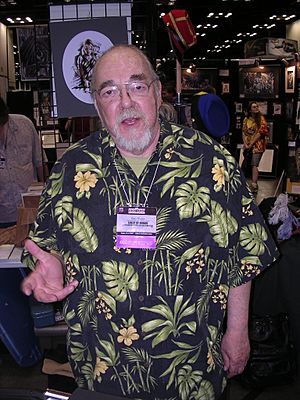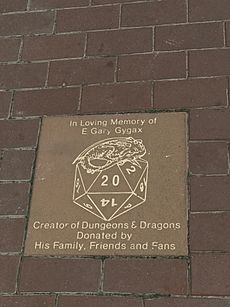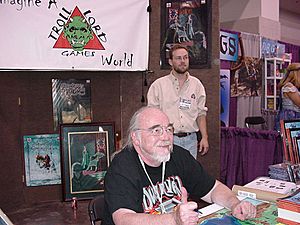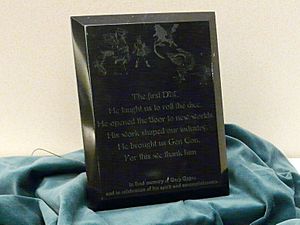Gary Gygax facts for kids
Quick facts for kids
Gary Gygax
|
|
|---|---|

Gygax at Gen Con Indy 2007
|
|
| Born | Ernest Gary Gygax July 27, 1938 Chicago, Illinois, U.S. |
| Died | March 4, 2008 (aged 69) Lake Geneva, Wisconsin, U.S. |
| Resting place | Oak Hill Cemetery (Lake Geneva, Wisconsin) |
| Nickname | "Father of role-playing games" |
| Occupation | Writer, game designer |
| Period | 1971–2008 |
| Genre | Role-playing games, fantasy, wargames |
| Spouse | Mary Jo Powell (m. 1958; div. 1983) Gail Carpenter (August 15, 1987; his death) |
| Signature | |
 |
|
|
|
|
Ernest Gary Gygax (born July 27, 1938 – died March 4, 2008) was an American game designer and author. He is most famous for helping create the first role-playing game called Dungeons & Dragons (D&D) with Dave Arneson.
In the 1960s, Gygax started groups for people who liked to play wargames. He also founded the Gen Con gaming convention, which is still very popular today. In 1971, he helped make Chainmail, a wargame using miniature figures based on medieval battles.
In 1973, he co-founded a company called Tactical Studies Rules (TSR, Inc.) with his friend Don Kaye. The next year, he and Arneson created D&D. This game built on Chainmail and added elements from the fantasy stories Gygax loved. He also started The Dragon magazine, which was all about the new game.
In 1977, Gygax began working on a bigger, more detailed version of the game called Advanced Dungeons & Dragons. He wrote many rulebooks and pre-made adventures for the game. These adventures, called "modules," gave the person running the game (the "Dungeon Master") ideas and a story to follow. In 1983, he helped turn D&D into a successful cartoon series for TV.
After leaving TSR in 1986, Gygax continued to create new role-playing games on his own. These included Dangerous Journeys in 1992 and Lejendary Adventure in 1999. In 2005, Gygax worked on the Castles & Crusades role-playing game. This game mixed ideas from the third edition of D&D with his original game concepts.
Gygax was married twice and had six children. He passed away in March 2008 after dealing with health issues.
Contents
Early Life and Game Ideas
Gygax was born in Chicago. His father was a Swiss immigrant and a violinist. Gary was named Ernest after his father, but everyone called him Gary. His mother named him after the actor Gary Cooper. His family lived close to Wrigley Field, so he could hear the crowds cheering for the Chicago Cubs.
When he was seven, he joined a group of friends called the "Kenmore Pirates." In 1946, his family moved to Lake Geneva, Wisconsin, where his mother's family lived. In Lake Geneva, Gygax made new friends, including Don Kaye and Mary Jo Powell.
As a child and teenager, he loved games and fantasy stories. He played card games like pinochle and board games like chess from a young age. By age ten, he and his friends played make-believe games, similar to what we now call "live action role-playing games." One friend would act as a referee for their adventures.
His father introduced him to pulp novels filled with science fiction and fantasy. This love for games and history led Gygax to start playing miniature war games in 1953 with Don Kaye. As teenagers, they even made their own rules for toy soldiers, using small firecrackers to pretend they were explosions!
Gygax loved authors like Robert E. Howard, Jack Vance, Fritz Leiber, and H. P. Lovecraft. He left high school in 1956 and joined the Marines. However, he received a medical discharge and moved back home. He then worked as a shipping clerk.
Around this time, he discovered Gettysburg, a wargame by Avalon Hill. Gygax became obsessed with it, playing for many hours. He also used blank maps from Avalon Hill to design his own games.
He reconnected with Mary Jo Powell, and they married when he was 19. They moved to Chicago, where Gygax continued working and took anthropology classes. Even with a job and family, he kept playing wargames. In 1962, he became an insurance underwriter. As his family grew, he moved them back to Lake Geneva, which remained his home for most of his life.
By 1966, Gygax was very involved in the wargame hobby. He wrote many articles for magazines. He also learned about old books on military miniatures wargames. Gygax looked for new ways to roll dice, using not just six-sided dice, but dice with 20 sides and other shapes.
He was influenced by many fantasy and science fiction writers, including Robert E. Howard, Jack Vance, and H. P. Lovecraft.
Creating Wargames
In 1967, Gygax helped start the International Federation of Wargamers (IFW). This group grew quickly and aimed to promote wargames. It helped gamers connect and share rules. In 1967, Gygax held a small gaming meeting in his basement, which was later called "Gen Con 0."
In 1968, he rented a hall for $50 to hold the first Lake Geneva Convention, now known as Gen Con. Today, Gen Con is one of the biggest game gatherings in North America. Gygax met Dave Arneson, who would later help create D&D, at the second Gen Con in 1969.
In 1970, Gygax and friends created a miniatures society called Lake Geneva Tactical Studies Association (LGTSA). Gygax also co-founded the Castle & Crusade Society.
In October 1970, Gygax lost his job. With five children, he tried to make a living by designing board games, but it wasn't enough. He started making shoes in his basement, which gave him a steady income and more time for game design.
In 1971, he edited games for Guidon Games. He also published Chainmail, a miniatures wargame he wrote with Jeff Perren. Chainmail included a fantasy section with rules for warriors, wizards, and monsters from fantasy stories. It sold well for a small publisher.
Gygax also helped create Tractics, which used 20-sided dice for combat. He also worked with Arneson on a naval wargame called Don't Give Up the Ship!
Dave Arneson used the Chainmail rules for his fantasy game world called Blackmoor. In late 1972, Arneson and David Megarry visited Gygax to show him their games. Gygax was very excited by Arneson's role-playing game. Gygax and Arneson immediately started working together on "The Fantasy Game," which became Dungeons & Dragons.
Two weeks later, Gygax had written 50 pages of rules. He tested the game with his children, Ernie and Elise, in a world he called "Greyhawk." This group quickly grew to include friends like Kaye and Kuntz. Gygax sent the rules to other wargamers for testing. Gygax and Arneson continued to share ideas, but Gygax made some changes that Arneson hadn't approved.
By mid-1973, Gygax had a 150-page version of the rules. The magic system was inspired by author Jack Vance's stories. The game also drew ideas from many other fantasy writers. Gygax asked Guidon Games to publish it, but the game was too big for them. Avalon Hill also turned it down because they didn't understand the idea of role-playing.
By 1974, Gygax's Greyhawk group had grown to over 20 players.
Starting TSR
In 1973, Gygax left Guidon Games. In October, he and Don Kaye founded Tactical Studies Rules, later known as TSR, Inc. They each put in $1,000 to print a thousand copies of the Dungeons & Dragons boxed set. They also tried to raise money by publishing another game, but it didn't sell well.
When printing costs for D&D went up, they still didn't have enough money. In December 1973, Brian Blume offered to invest $2,000 in TSR to become an equal partner. This investment finally allowed them to publish D&D. Gygax also worked on rules for other games like Classic Warfare and Warriors of Mars.
TSR released the first D&D boxed set in January 1974. The first 1,000 copies, put together by hand in Gygax's home, sold out in less than a year.
In January 1975, Don Kaye sadly died of a heart attack. His wife, Donna, inherited his share of the company but wasn't interested in running it. Gygax and Blume reorganized the company into TSR Hobbies. Brian Blume's father, Melvin Blume, bought Donna Kaye's shares. This made the Blume family the majority owners, and Gygax became a minority shareholder.
Gygax wrote more books for the original D&D game, including Greyhawk and Eldritch Wizardry. He also designed the wild west role-playing game Boot Hill with Brian Blume.
In 1975, Gygax started a magazine called The Strategic Review. He later hired Tim Kask to turn it into a fantasy magazine called The Dragon. The Dragon started in June 1976 and became very successful.
In 1976, TSR moved out of Gygax's house into its first office. Dave Arneson was hired but left after ten months, showing that he and Gygax had different ideas for D&D.
Advanced Dungeons & Dragons and Hollywood
The Dungeons & Dragons Basic Set, released in 1977, was an easier version of D&D for new players. In the same year, TSR Hobbies released a completely new and more complex game called Advanced Dungeons & Dragons (AD&D). The Monster Manual was the first rulebook for AD&D.
AD&D rules were not fully compatible with the D&D Basic Set, so they became separate game lines. This caused more disagreement between Gygax and Arneson. Arneson received royalties for D&D products, but Gygax refused to pay him for AD&D books, saying it was a new game. In 1979, Arneson sued TSR. They settled in 1981, and Arneson received royalties on AD&D products.
Gygax wrote many AD&D rulebooks like the Players Handbook and Dungeon Masters Guide. He also wrote many adventure modules, including The Keep on the Borderlands and Tomb of Horrors. In 1980, Gygax's long-time game world, Greyhawk, was published. D&D sales reached $8.5 million in 1980.
In 1979, a college student named James Dallas Egbert III was thought to have disappeared while playing a live-action D&D game. He was found later, but the media blamed D&D. In 1982, Patricia Pulling's son died. She blamed D&D and started an organization called B.A.D.D. (Bothered About Dungeons & Dragons) to criticize the game. Gygax defended the game on a TV show called 60 Minutes in 1985. He even hired a bodyguard because of threats.
Despite the negative attention, D&D sales grew to $16 million in 1982. In 1983, The New York Times suggested D&D could be the big game of the 1980s.
The Blume brothers gained more control of TSR, and Gygax and the Blumes often disagreed about how to run the company. Gygax also went through a divorce in 1983.
The Blumes sent Gygax to Hollywood to develop TV and movie ideas for TSR. He became a co-producer for the D&D cartoon series for CBS, which was very popular.
Leaving TSR
While Gygax was in Hollywood, the Blume brothers managed TSR. In 1984, Gygax was close to making a D&D movie with Orson Welles and John Boorman. But then he learned that TSR was in serious financial trouble.
Gygax stopped his movie plans and returned to Lake Geneva. He found that TSR, despite making $30 million, was nearly $1.5 million in debt. Gygax believed this was due to Kevin Blume's poor management. Gygax demanded Blume be removed as president. To regain control, Gygax bought more shares in the company in 1985, giving him just over 50% ownership. He became president and CEO.
He tried to create new products to make money. He contacted Arneson to work on Blackmoor material. He also relied on a new AD&D book, Unearthed Arcana, which sold 90,000 copies in its first month. Gygax also wrote a novel set in his Greyhawk world, Saga of Old City, which sold well. He hired Lorraine Williams to help manage the company's finances.
However, in October 1985, Williams bought all the shares from the Blume brothers. This made Williams the majority owner, and she replaced Gygax as president and CEO. She also made it clear that Gygax would not create new content for TSR. Many of his projects were stopped. Gygax tried to block the sale in court but lost.
D&D sales reached $29 million in 1985. But Gygax saw no future for himself at TSR. He resigned from all his positions in October 1986. In their settlement, he kept the rights to his character Gord the Rogue and some characters whose names were based on his own. However, he lost the rights to most of his other work, including the World of Greyhawk and many character names.
After TSR
New Infinities Productions
After leaving TSR, Gygax was approached by Forrest Baker, who wanted to start a new gaming company. Gygax wanted to publish more of his Gord the Rogue novels. Baker promised to handle the business side, while Gygax would focus on creative work. Gygax agreed, and New Infinities Productions, Inc. (NIPI) was announced in 1986.
Gygax hired Frank Mentzer and Kim Mohan from TSR to help him. But Baker left NIPI when he couldn't get the promised investments. Gygax was back in charge. He published more Gord the Rogue novels, starting with Sea of Death (1987), which kept New Infinities going.
Mentzer and Mohan also wrote a science fiction RPG called Cyborg Commando (1987), but it didn't sell well. NIPI still depended on the Gord the Rogue books.
TSR also filed a lawsuit against NIPI over an adventure module, which cost NIPI a lot of money.
During this time, Gygax had another child, Alex, with Gail Carpenter, his former assistant. Gary married Gail Carpenter on August 15, 1987.
Gygax wrote more Gord the Rogue novels. However, TSR changed the Greyhawk world, and Gygax didn't like the new direction. In his last Gord the Rogue novel, Dance of Demons, Gygax destroyed his version of the Greyhawk world to make a clean break.
With the Gord the Rogue novels finished, NIPI lost its main income. Gygax announced a new multi-genre fantasy RPG called "Infinite Adventures" with Robert Kuntz. This game would detail the Castle and City of Greyhawk as they had originally imagined them, now called "Castle Dunfalcon." However, NIPI ran out of money and closed down in 1989.
Dangerous Journeys
After NIPI closed, Gygax decided to create a completely new RPG called The Carpenter Project. This game would be more complex than his original D&D system. He also wanted to create a horror setting for it. Game Designers' Workshop became interested in publishing the new system.
JVC and NEC also showed interest, wanting to turn the RPG into computer games. They preferred a fantasy setting called Mythus over the horror setting. Work went well until March 1992, when TSR sued, claiming the name Dangerous Dimensions was too similar to Dungeons & Dragons. Gygax quickly changed the name to Dangerous Journeys.
The plan for Dangerous Journeys: Mythus included the RPG, a computer game, and a series of books by Gygax. He wrote three novels: The Anubis Murders, The Samarkand Solution, and Death in Delhi.
In late 1992, Dangerous Journeys was released. But TSR immediately sued again, claiming Dangerous Journeys was too similar to D&D and AD&D. Even though the lawsuit failed to stop the game, TSR continued with legal action. NEC and JVC pulled out of the computer game project. By 1994, the legal costs had used up all of Gygax's money. He offered to settle, and TSR paid Gygax for the full rights to Dangerous Journeys and Mythus. TSR then stopped publishing both games.
Lejendary Adventures
In 1995, Gygax started working on a new computer role-playing game called Lejendary Adventures. This system was simpler than Dangerous Journeys. Although he couldn't release a computer game, Gygax decided to publish it as a tabletop game.
In 1996, Wizards of the Coast bought TSR. In 1997, Christopher Clark suggested Gygax create adventures to sell while TSR was busy. This led to two fantasy adventures: A Challenge of Arms (1998) and The Ritual of the Golden Eyes (1999). Gygax and Clark formed a partnership called Hekaforge Productions, which allowed Gygax to publish Lejendary Adventures in 1999. The game came out as a three-book set.
The new owner of TSR, Peter Adkison, bought all of Gygax's remaining rights to D&D and AD&D for a large sum of money. Gygax didn't write new books for TSR or WotC, but he did write the introduction for the 1998 adventure Return to the Tomb of Horrors. He also wrote a column for Dragon Magazine from 2000 to 2004.
Later Works and Passing
Gygax continued to work on Lejendary Adventures, which he believed was his best work, but sales were lower than expected.
In 2001, Troll Lord Games announced that Gygax would write books for their company. His early work for them included "Gygaxian Fantasy Worlds," which looked at the underworld and game design. Troll Lord also published some adventures with Gygax.
By 2002, Gygax had given Christopher Clark of Hekaforge a large text describing the Lejendary Earth. Clark divided it into five books. Hekaforge published the first two, but then had financial problems. Troll Lord Games helped by publishing the remaining Lejendary Adventures books.
In 2001, Necromancer Games announced they would publish a d20 version of Necropolis, an adventure Gygax had planned earlier. Gary Gygax's Necropolis was published a year later.
Gygax also did voiceover narration for cartoons and video games. In 2000, he voiced himself in an episode of Futurama. He also appeared as a guest Dungeon Master in the online game Dungeons & Dragons Online: Stormreach.
Gygax had often mentioned the mysterious Castle Greyhawk from his home game. In 2003, Gygax announced he was working with Rob Kuntz again to publish the original details of Castle Greyhawk and the City of Greyhawk. This project would use the rules for Castles and Crusades.
Since Wizards of the Coast owned the rights to the name "Greyhawk," Gygax changed the name of Castle Greyhawk to "Castle Zagyg" (his name spelled backward). He also changed the city's name to "Yggsburgh."
The project was huge. The castle dungeons had 50 levels with thousands of rooms and traps. Gygax decided to shorten the castle dungeons to 13 levels, like his original Castle Greyhawk in 1973. He and Kuntz had to go through old notes and memories to recreate the details. Recreating the city was also a challenge, as WotC owned his previous work on it.
Due to creative differences, Kuntz left the project. Gygax continued working on Castle Zagyg alone. However, his work slowed down after he had two serious strokes in April 2004. His work time was reduced from 14 hours a day to only one or two.
In 2005, Castle Zagyg Part I: Yggsburgh, the first book in the series, was released. Troll Lord Games also published Castle Zagyg: Dark Chateau (2005), an adventure module by Rob Kuntz.
That same year, Gygax was diagnosed with a serious health condition. Doctors recommended surgery, but Gygax refused, believing he might not survive it. He passed away in March 2008. Three months after his death, Gygax Games, a new company formed by his widow Gail, ended all of Gygax's licenses with Troll Lord and Hekaforge.
Personal Life
From a young age, Gygax enjoyed hunting and target shooting with bows and guns. He also collected guns and owned various rifles, shotguns, and handguns.
Awards and Honors
As the "father of role-playing games," Gygax received many awards and tributes:
- He was added to the Academy of Adventure Gaming Arts and Design Origins Award Hall of Fame in 1980.
- Sync magazine named Gygax number one on their list of "The 50 Biggest Nerds of All Time."
- SFX magazine listed him as number 37 on their list of the "50 Greatest SF Pioneers."
- In 1999, Pyramid magazine named Gygax as one of "The Millennium's Most Influential Persons" in adventure gaming.
- Gygax was tied with J. R. R. Tolkien for number 18 on GameSpy's "30 Most Influential People in Gaming."
- A type of bacteria was named in his honor: "Arthronema gygaxiana sp nov UTCC393."
- He was inducted into the Pop Culture Hall of Fame Class of 2019.
In 2008, Gail Gygax, Gary's widow, started working to create a memorial for him in Lake Geneva. In 2011, the city approved a site for the memorial. The design is a stone castle with medieval weapons, a family crest, and a dragon.

In 2014, with his eldest son Ernie's approval, a Kickstarter campaign began to raise money for a museum dedicated to Gary. It would include a gaming center and a hall of fame for authors, artists, and game masters.
See also
 In Spanish: Gary Gygax para niños
In Spanish: Gary Gygax para niños
- Gary Gygax bibliography




